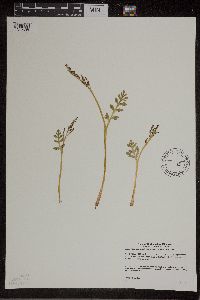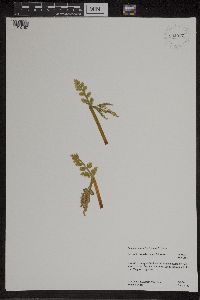Botrychium matricariifolium
|
|
|
|
Family: Ophioglossaceae
Daisy-Leaf Moonwort
[Botrychium neglectum f. gracile House] |
Trophophore stalk 0--5 mm, to 1/6 length of trophophore rachis; blade dull, ± glaucescent green, oblong, 1--3-pinnate, to 10 × 9 cm, firm. Pinnae to 7 pairs, somewhat ascending, approximate to slightly remote, distance between 1st and 2d pinnae not or slightly more than between 2d and 3d pairs, basal pinna pair approximately equal in size and cutting to adjacent pairs, spatulate-ovate to narrowly ovate, divided to tip, ultimate segments squarish to linear, rounded to square to acute at apex, margins entire to lobed to fully dissected, apex rounded to acute, venation pinnate. Sporophores 1--3-pinnate, 1.3--2.4 times length of trophophore. 2 n =180. Leaves appearing in spring, dying in late summer. Old fields, secondary growth woods; 0--1200 m; St. Pierre and Miquelon; N.B., Nfld., N.S., Ont., Que.; Conn., Del., D.C., Ill., Ind., Iowa, Ky., Maine, Md., Mass., Mich., Minn., N.H., N.J., N.Y., N.C., Ohio, Pa., R.I., Tenn., Vt., Va., W.Va., Wis.; Europe. Perennial fern 5 - 28 cm tall Stem: single, upright, very short and inconspicuous, up to 5 mm in diameter with a thickened base (caudex). Spores: thousands per sac, all of one kind, three-sectioned (trilete), thick-walled, and with a bumpy or pimply surface. The spores give rise to the gametophyte (the sexual phase of the plant), which is broadly egg-shaped, unbranched, tiny (1 - 3 mm tall, 1 - 10 mm diameter), fleshy, not green, underground, saprophytic, and inhabited by symbiotic fungi (mycorrhizae). Leaf: one per stem, on stalk arising from an expanded, clasping base, which forms a closed sheath around stem apex. The single leaf is made up of two parts arising from a shared stalk: a sterile, green, expanded blade portion (trophophore); and a fertile, stalk-like, spore-bearing portion (sporophore). Leaves appear in spring and die in late summer. Roots: up to ten per plant, yellow or brown, 0.5 - 1.5 mm in diameter, and originating 1 cm below the base of the plant. Similar species: In the Chicago Region, Botrychium matricariifolium is probably most similar to B. campestre, but the sterile blade (trophophore) of that species is folded lengthwise, the pinnae are more linear, and the basal pair of pinnae have fanlike venation without a midrib. Also similar is B. simplex, but that species usually has larger and more obvious trophophores with more rounded or fan-shaped pinnae. All of our other species have trophophore blades that are widely triangular, wider than long, and pinnately compound multiple times. Habitat and ecology: Rare, found only in our eastern section, preferring somewhat open conditions such as secondary growth woods or old fields. Occurence in the Chicago region: native Notes: The trophophore blades of this species almost resemble the leaves of daisies, hence its common name of the daisy-leaved moonwort. Etymology: Botrychium is a diminutive of the Greek combination of botrys, a cluster of grapes, referring to the appearance of the fruiting cluster. Matricariifolium means "with the leaves of Matricaria, a genus in the Asteraceae family. Author: The Field Museum Plants 5-28 cm, wholly glabrous; bud with the blade bent over at the tip and clasping the erect sporophore; blade supramedial on the apparent stem, deciduous, with a 2-15 mm stalk, submembranous, oblong or ovate, mostly 1.5-7(-9) נ0.4-7(-7) cm, the pinnae 2-7 pairs, subopposite, obtuse or acutish, obtusely sublobate or in well developed plants again pinnatifid with obtusely lobed segments; sporophore 3-12+ cm, pinnate or bipinnate, its stalk 1-
4 cm; 2n=180. Thickets and rich woods in subacid soil; circumboreal, in Amer. from Nf. to Alta., s. to N.J., Md., Va., N.C., Tenn., n. O., Wis., S.D., and Colo.; Patagonia. June-Aug. Ours is var. matricariifolium. (B. neglectum; B. oblanceum; B. pseudopinnatum; B. ramosum of auth.) Gleason, Henry A. & Cronquist, Arthur J. 1991. Manual of vascular plants of northeastern United States and adjacent Canada. lxxv + 910 pp. ©The New York Botanical Garden. All rights reserved. Used by permission. From Flora of Indiana (1940) by Charles C. Deam Indiana Coefficient of Conservatism: C = 4 Wetland Indicator Status: FACU |





















































































